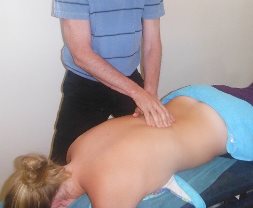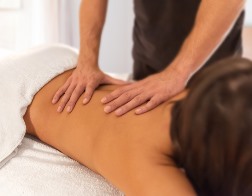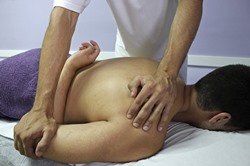What is Massage Therapy?
 As mentioned in the introduction, massage therapy is an alternative form of healing that helps people feel and function better. The massage therapist manually stimulates muscles, tissue and skin to diminish stress and eliminate pain and tension in their clients. Swedish, or Classic Massage, is the kind of massage that many people think of when researching massage therapy, and most Penn IN massage therapy schools offer it as their primary form of massage. But keep in mind, there are many other types of massage that schools have the option to include within their course of instruction. Below are just a few examples.
As mentioned in the introduction, massage therapy is an alternative form of healing that helps people feel and function better. The massage therapist manually stimulates muscles, tissue and skin to diminish stress and eliminate pain and tension in their clients. Swedish, or Classic Massage, is the kind of massage that many people think of when researching massage therapy, and most Penn IN massage therapy schools offer it as their primary form of massage. But keep in mind, there are many other types of massage that schools have the option to include within their course of instruction. Below are just a few examples.
- Neuromuscular Therapy Massage
- Deep Tissue Massage
- Sports Massage
- Shiatsu Massage
- Thai Massage
- Hot Stone Massage
- Pregnancy Massage
Practitioners that work in therapeutic massage should be referred to as massage therapists. On occasion you might hear them called a masseuse or a masseur, which is generally the name of a female or a male massage professional. Unfortunately, these terms typically have a derogatory connotation among the general public and Penn IN professionals alike and are better avoided.
Massage Therapist Training Requirements
 The majority of Penn IN schools offering massage therapy require that the enrollee has earned a high school diploma or a GED to qualify. Programs can vary in length from a few months for a Certificate or a Diploma to as long as 2 years for an Associate’s Degree. How long the programs are will also be State specific based on the training hours required for licensing. Another factor that can also influence the length of the program is whether classes are offered during the day or at night. In addition, an Associate Degree in Massage Therapy often has general studies requirements and are often transferrable into a related Bachelor’s Degree Program. Once you have earned your Certificate or Degree, the education doesn’t stop there. The type and amount of continuing education you are required to complete will vary based on the State where you are licensed. Some states require both a certain number of hours of continuing education as well as specific education in subjects, such as HIPPA compliance or ethics.
The majority of Penn IN schools offering massage therapy require that the enrollee has earned a high school diploma or a GED to qualify. Programs can vary in length from a few months for a Certificate or a Diploma to as long as 2 years for an Associate’s Degree. How long the programs are will also be State specific based on the training hours required for licensing. Another factor that can also influence the length of the program is whether classes are offered during the day or at night. In addition, an Associate Degree in Massage Therapy often has general studies requirements and are often transferrable into a related Bachelor’s Degree Program. Once you have earned your Certificate or Degree, the education doesn’t stop there. The type and amount of continuing education you are required to complete will vary based on the State where you are licensed. Some states require both a certain number of hours of continuing education as well as specific education in subjects, such as HIPPA compliance or ethics.
Massage Therapy Licensing
 Once you have graduated from an accredited Penn IN massage therapy school, you will then need to become licensed in the State where you will be practicing. The Massage & Bodywork Licensing Examination (MBLEx), is a test conducted and controlled by the Federation of State Massage Therapy Boards (FSMTB) and is mandated by most States as part of the licensing process. Some States have additional tests or their own, so check with your State before enrolling in a massage therapy school. If you do not pass the MBLEx in your initial attempt, you can take it again after thirty days but must pay an additional exam fee. Once licensed, you will need to renew it in most states, which means paying a renewal fee and satisfying renewal requirements. As earlier stated, completion of a specific number of continuing education hours are usually required as a prerequisite for renewal. And if you decide to move to a different State, licensing will be required for that new State also. Every State regulates massage therapy differently, so it is not safe to assume that you will automatically qualify for licensing. Confirm with your new State prior to moving that you meet the requirements to legally practice there.
Once you have graduated from an accredited Penn IN massage therapy school, you will then need to become licensed in the State where you will be practicing. The Massage & Bodywork Licensing Examination (MBLEx), is a test conducted and controlled by the Federation of State Massage Therapy Boards (FSMTB) and is mandated by most States as part of the licensing process. Some States have additional tests or their own, so check with your State before enrolling in a massage therapy school. If you do not pass the MBLEx in your initial attempt, you can take it again after thirty days but must pay an additional exam fee. Once licensed, you will need to renew it in most states, which means paying a renewal fee and satisfying renewal requirements. As earlier stated, completion of a specific number of continuing education hours are usually required as a prerequisite for renewal. And if you decide to move to a different State, licensing will be required for that new State also. Every State regulates massage therapy differently, so it is not safe to assume that you will automatically qualify for licensing. Confirm with your new State prior to moving that you meet the requirements to legally practice there.
